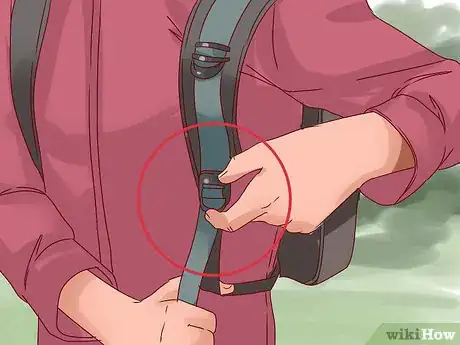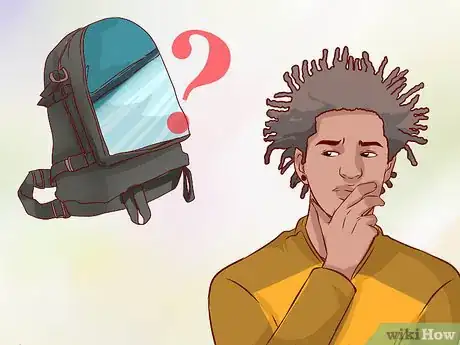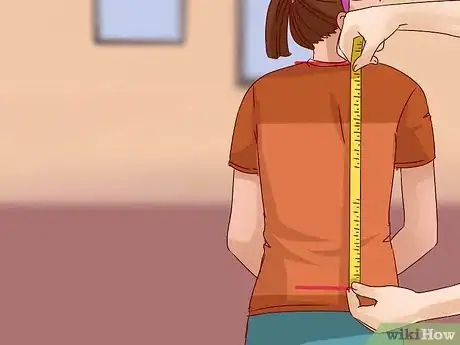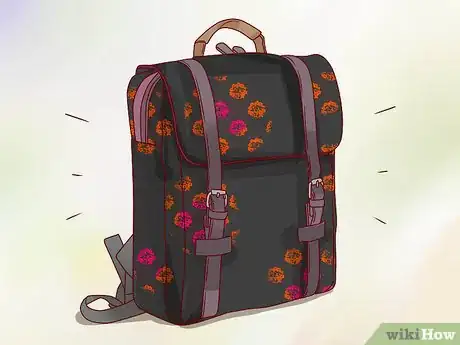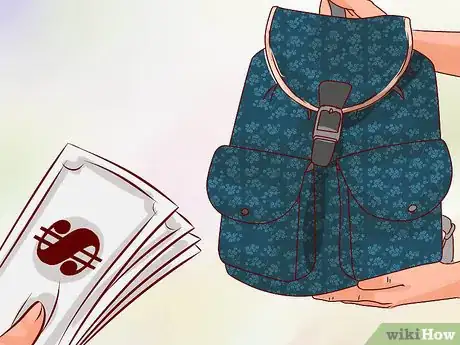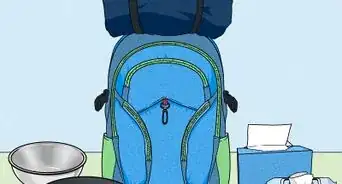This article was co-authored by wikiHow Staff. Our trained team of editors and researchers validate articles for accuracy and comprehensiveness. wikiHow's Content Management Team carefully monitors the work from our editorial staff to ensure that each article is backed by trusted research and meets our high quality standards.
There are 8 references cited in this article, which can be found at the bottom of the page.
This article has been viewed 52,136 times.
Learn more...
Whether you need a new backpack for school, work, or travel you will need to find one that matches your needs and learn to wear it properly. Incorrectly wearing your backpack can result in a sore or injured back. You might also want to personalize your backpack before wearing it to show off your style and make it easy to have returned to you if misplaced or lost.
Steps
Wearing A School Backpack
-
1Adjust your backpack. Before you fill up your backpack and start wearing it, you will want to properly adjust your backpack. Adjusting your backpack can help make it more comfortable and help prevent injury. Make sure your backpack fits properly before you start regularly using it.[1]
- Most backpacks will have an area on the straps that you can use to adjust the length of the straps themselves.
- Pulling more or less strap through the buckle will adjust how long the straps are.
- Adjust the straps of the backpack until it fits snugly against your back.
- Avoid leaving too much slack in the straps of the backpack as wearing the backpack too low can hurt your back.
- Make sure both straps are an equal length to ensure that the weight of your backpack is evenly distributed.
-
2Fill up your backpack. Once your backpack is correctly adjusted and customized, you can start to fill it up with whatever you need to carry. Be careful when packing your bag to prevent fragile items from being broken. Take some time to see how your items will best fit in your bag before putting it on to wear it.[2]
- Fragile items should go on top of more durable ones.
- Some items may have an usual shape or sharp corners. Try to position these so that they don't poke you in the back.
- Make sure any containers storing liquids are secure before adding them to your bag.
- Don't carry more than 10%-15% of your body weight in your backpack to avoid injury.[3]
Advertisement -
3Wear your backpack. Now that your bag is full and adjusted, it's ready to wear. Most backpacks will have two shoulder straps that will both need to be used. Put an arm through each of the shoulder straps to make sure the weight is properly held by your backpack. Take note of how comfortable the bag feels with items in it and make adjustments if needed.[4] [5]
- Do not wear your backpack with only one shoulder strap. Each arm should go through a shoulder strap.
- Backpacks should not drop below the waist level. Don't wear your backpack slung low on your back.[6]
- You may need to adjust how you packed your items to evenly distribute the weight.
- Some backpacks will have an additional waist strap that can add more stability when worn.
-
4Personalize your backpack. After you have found a great backpack, you can start to personalize it. Personalizing your backpack can help keep it identifiable and allow you to express yourself at the same time. Consider adding some contact information or other personal stylistic elements like patches, drawings, or tags to make your backpack feel like your own.
- Writing your name and phone number on your bag can help it get back to you if lost.
- Customizing your bag can help you identify it easily if it's near similar bags.
Wearing A Hiking Backpack
-
1Think about what type of hiking backpack you need. Not all hiking trips will be the same and there are varying styles of backpacks that can meet the demands of these differences. Depending on the length of your hike and the gear you need to carry you will need to purchase a backpack with the correct frame style.[7]
- Backpacks with external frames are mainly used for heavy and asymmetrical loads.
- An internal frame backpack might be right for you if you need to maintain stability and don't need to carry heavy items.
- Frame-less backpacks are for those hikers who don't need to carry much gear with them and like to move quickly on their hike.
-
2Measure your torso. Hiking backpacks will need to be fitted exactly to the size of your torso. Any backpack that isn't the right size won't fit correctly and will be uncomfortable or may cause injury. Measure your torso's length and hip width before you buy your backpack to ensure a great fit.
- Measure your torso's length by starting from the top bump at the base of your neck down to your hip level.
- Measure your hips to make sure that the hip belt will fit. Your hip measurement will be taken just above where your pants normally rest.
-
3Fit your backpack. Before you load up your backpack and head out hiking you will need to properly fit your backpack. Try wearing your backpack and then making adjustments using the straps on your backpack where needed. There will generally be four main areas to adjust including the hip-belt, shoulder straps, load lifters, and sternum straps.[8] [9]
- The hip-belt should fit snugly around your hips and will support much of the weight.
- Shoulder straps should pull the bag tight against your back but not actually carry much of the weight.
- Some backpacks will have load-lifting straps. These should relieve the weight from your shoulders and help keep it properly distributed.
- The sternum strap will pull the weight up and away from your shoulders and should fight tightly and comfortably across your chest.
-
4Try on the backpack. When it comes to hiking backpacks, it is ideal to visit a store where you can try on the backpacks in person. Although you might know your measurements, each backpack might fight differently in actuality. Try on plenty of backpacks before purchasing one to make sure you find the right fit.[10]
- If you are unable to visit a store you may still be able to try a backpack and return it free of charge if the manufacturer allows for it.
Purchasing A Backpack
-
1Consider what size you will need. The size of your backpack will vary depending on what you plan on carrying in it. Decide on what items you will regularly be using your backpack to carry and plan on buying a bag that will easily accommodate them all.
- If you need to carry bigger items or many small items you may need to buy a large backpack.
- Buy smaller backpack if you don't plan on carrying much with you regularly.
- Think about how easy your backpack will be to store when you arrive at school or work.
- Whichever size you choose, you should never carry more than 15% of your body weight.
-
2Think about how often you will use your backpack. When shopping for your backpack you will want to consider the durability and quality of it before purchasing one. Think about how often you plan on using your backpack and buy a backpack to match your needs.
-
3Select your favorite style. Since you will be wearing your backpack you will want to select one that matches your personal taste and style. Backpacks come in almost any style, color, or design that you can imagine. Take your time and find one that matches your needs and looks great.
- If you plan on bringing the bag everywhere try to find one that is neutral in style or one that matches most of your clothes.
- If you are taking your backpack to school or work try to avoid any imagery or styles that might not be appropriate.
-
4Buy your backpack. After you have thought about which backpack might best suit your needs and style it's time to buy it. Once you buy your backpack you can adjust it and start putting it to use, carrying your important items with you wherever needed.
- Compare prices offered by different vendors before buying your backpack to get the best deal.
- If you are buying online there may be added costs for shipping.
- Buying in person can allow you to get a better feel of the quality and style of the backpack.
Community Q&A
-
QuestionHow should I wear a backpack with a hoodie?
 Community AnswerWith the hood not pressed against your back by the backpack. Free the hood of the hoodie over the top of the backpack.
Community AnswerWith the hood not pressed against your back by the backpack. Free the hood of the hoodie over the top of the backpack. -
QuestionIs it okay to drag a backpack along the ground?
 TreetopGirraffeCommunity AnswerTheoretically speaking, you could, but it would damage your bag. It is best to wear it on your back.
TreetopGirraffeCommunity AnswerTheoretically speaking, you could, but it would damage your bag. It is best to wear it on your back. -
QuestionWhat is a backpack?
 Community AnswerIt is a satchel but you wear it on your back. If you do not know what a satchel is, it is a bag that holds things. Take a look at the pictures in the article.
Community AnswerIt is a satchel but you wear it on your back. If you do not know what a satchel is, it is a bag that holds things. Take a look at the pictures in the article.
Warnings
- Improperly wearing your backpack can cause injury.⧼thumbs_response⧽
- Do not over-pack your bag or carry extremely heavy items in it as this can result in injury.⧼thumbs_response⧽
References
- ↑ http://kidshealth.org/teen/school_jobs/school/backpack.html#
- ↑ http://www.hcpss.org/f/newlanguages/docs/guidelines_backpack.pdf
- ↑ http://fox4kc.com/2014/09/11/chiropractor-shows-proper-way-to-wear-backpack/
- ↑ http://www.hcpss.org/f/newlanguages/docs/guidelines_backpack.pdf
- ↑ https://www.bu.edu/articles/2019/backpack-safety-101/
- ↑ http://www.nsc.org/learn/safety-knowledge/Pages/backpack-safety-for-kids.aspx
- ↑ http://www.rei.com/learn/expert-advice/backpack.html
- ↑ http://www.rei.com/learn/expert-advice/backpacks-adjusting-fit.html
- ↑ http://sectionhiker.com/how-to-fit-a-backpack/
